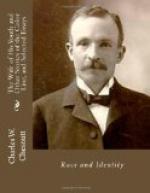It may be said, in passing, that the word “Negro,” where used in this paper, is used solely for convenience. By the census of 1890 there were 1,000,000 colored people in the country who were half, or more than half, white, and logically there must be, as in fact there are, so many who share the white blood in some degree, as to justify the assertion that the race problem in the United States concerns the welfare and the status of a mixed race. Their rights are not one whit the more sacred because of this fact; but in an argument where injustice is sought to be excused because of fundamental differences of race, it is well enough to bear in mind that the race whose rights and liberties are endangered all over this country by disfranchisement at the South, are the colored people who live in the United States to-day, and not the lowbrowed, man-eating savage whom the Southern white likes to set upon a block and contrast with Shakespeare and Newton and Washington and Lincoln.
Despite and in defiance of the Federal Constitution, to-day in the six Southern States of Mississippi, Louisiana, Alabama, North Carolina, South Carolina and Virginia, containing an aggregate colored population of about 6,000,000, these have been, to all intents and purposes, denied, so far as the States can effect it, the right to vote. This disfranchisement is accomplished by various methods, devised with much transparent ingenuity, the effort being in each instance to violate the spirit of the Federal Constitution by disfranchising the Negro, while seeming to respect its letter by avoiding the mention of race or color.
These restrictions fall into three groups. The first comprises a property qualification—the ownership of $300 worth or more of real or personal property (Alabama, Louisiana, Virginia and South Carolina); the payment of a poll tax (Mississippi, North Carolina, Virginia); an educational qualification—the ability to read and write (Alabama, Louisiana, North Carolina). Thus far, those who believe in a restricted suffrage everywhere, could perhaps find no reasonable fault with any one of these qualifications, applied either separately or together.
But the Negro has made such progress that these restrictions alone would perhaps not deprive him of effective representation. Hence the second group. This comprises an “understanding” clause—the applicant must be able “to read, or understand when read to him, any clause in the Constitution” (Mississippi), or to read and explain, or to understand and explain when read to him, any section of the Constitution (Virginia); an employment qualification—the voter must be regularly employed in some lawful occupation (Alabama); a character qualification—the voter must be a person of good character and who “understands the duties and obligations of citizens under a republican [!] form of government” (Alabama). The qualifications under the first group it will be seen, are capable of exact demonstration; those under the second group are left to the discretion and judgment of the registering officer—for in most instances these are all requirements for registration, which must precede voting.




